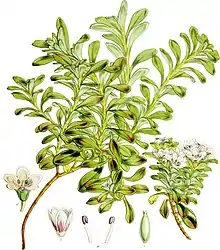Gentianella cerina
Gentianella cerina (common name - Auckland Island gentian)[3] is a plant species in the Gentianaceae family, endemic to the Auckland Islands of New Zealand.[3][4]
| Gentianella cerina | |
|---|---|
 | |
| Plate XXXVI[1] | |
| Scientific classification | |
| Kingdom: | Plantae |
| Clade: | Tracheophytes |
| Clade: | Angiosperms |
| Clade: | Eudicots |
| Clade: | Asterids |
| Order: | Gentianales |
| Family: | Gentianaceae |
| Genus: | Gentianella |
| Species: | G. cerina |
| Binomial name | |
| Gentianella cerina | |
| Synonyms[4] | |
|
Chionogentias cerina (Hook.f.) L.G.Adams | |
Description
Gentianella cerina has a thick trunk (caudex) which may be unbranched or branched and of a height from 110–200 mm. There are 3–12 flowering stems per plant (1.1–3.1 mm in diameter) and these may be terminal or lateral. The lateral flowering stems spread horizontally with the ends growing upwards (i.e., they are decumbent). The leaves are elliptic, 36.6–53.1 by 8.4–12.6 mm) and are flat, with thickened margins. The leaf apex is rounded and the distinct petiole is 11–13 mm by 4.7–6.3 mm. Leaves on flowering stems are the same but smaller. There are 15 to more than 100 flowers per plant, which are 9.9–14.1 mm long. The calyx is 9.3–12.2 mm long and there are hairs at calyx–corolla fusion line. The corolla is 8.4–11.8 mm long, and white or tinted red to purple, with colourless or purple veins. The tube is 2.1–4.4 mm long and the lobes are 6.3–8.8 by 3.8–5.0 mm. The pollen is yellow and the stigma is purple or colourless. There are 13–37 ovules per ovary, and the capsule is 6.5–12 mm long. It flowers from December to April.[3]
Taxonomy
It was first described in 1844 by Joseph Dalton Hooker as Gentiana cerina.[5][1] Its currently accepted name is Gentianella cerina, having been assigned to the genus Gentianella by the authors, Ho and Liu in 1993.[5][6]
Conservation status
In both 2009 and 2012 it was deemed to be "At Risk - Naturally Uncommon" under the New Zealand Threat Classification System,[3] and this classification was reaffirmed in 2018, due to the species being an island endemic and having a restricted range.[2]
References
- Hooker, J.D. (1844). "Gentiana cerina". The botany of the Antarctic voyage of H.M. discovery ships Erebus and Terror in the Years 1839-1843 :under the command of Captain Sir James Clark Ross. 1: 54. Plate XXXVI
- Lange, Peter J. de; Rolfe, Jeremy R.; Barkla, John W.; Courtney, Shannel P.; Champion, Paul D.; Perrie, Leon R.; Beadel, Sarah M.; Ford, Kerry A.; Breitwieser, Ilse; Schönberger, Ines; Hindmarsh-Walls, Rowan (2018). "Conservation status of New Zealand indigenous vascular plants, 2017" (PDF). New Zealand Threat Classification Series. 22: 44. OCLC 1041649797.
- "Gentianella cerina | New Zealand Plant Conservation Network". nzpcn.org.nz. Retrieved 24 January 2020.
- "Gentianella cerina (Hook.f.) T.N.Ho & S.W.Liu | Plants of the World Online | Kew Science". Plants of the World Online. Retrieved 23 January 2020.
- "Gentianella cerina - International Plant Names Index". www.ipni.org. Retrieved 24 January 2020.
- T.N.Ho & S.W.Liu (1993). "Gentianella cerina". Bulletin of the Natural History Museum. London, Botany. 23 (2): 62.
